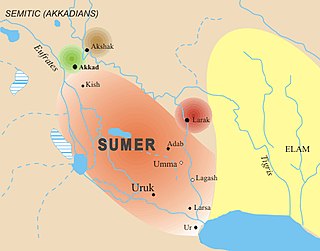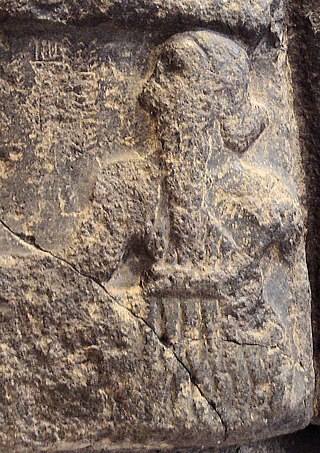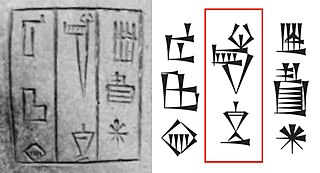| Sarlagab or Zarlagab | |
|---|---|
| King of Sumer | |
| Reign | fl. late 3rd millennium BC |
| Predecessor | Inkishush |
| Successor | Shulme |
| House | Gutian Dynasty of Sumer |
Sarlagab or Zarlagab (c. 2200 BC) [1] [2] [3] ) was the second Gutian ruler of the Gutian Dynasty of Sumer mentioned on the Sumerian King List as possibly reigning for six years.
Sarlagab may have been a contemporary of the Akkadian king Shar-kali-sharri (r. 2217-2193 BC), if he is the same Gutian king Sharlag whom Shar-kali-sharri captured according to one of his year-names: "the year in which Szarkaliszarri (...) took prisoner Szarlag(ab) the king of Gutium". [4] [5] According to the King List, he was the successor of Inkishush. Shulme then succeeded Sarlagab.

The Akkadian Empire was the first ancient empire of Mesopotamia, succeeding the long-lived civilization of Sumer. Centered on the city of Akkad and its surrounding region, the empire would unite Akkadian and Sumerian speakers under one rule and exercised significant influence across Mesopotamia, the Levant, and Anatolia, sending military expeditions as far south as Dilmun and Magan in the Arabian Peninsula.

The Sumerian King List or Chronicle of the One Monarchy is an ancient literary composition written in Sumerian that was likely created and redacted to legitimize the claims to power of various city-states and kingdoms in southern Mesopotamia during the late third and early second millennium BC. It does so by repetitively listing Sumerian cities, the kings that ruled there, and the lengths of their reigns. Especially in the early part of the list, these reigns often span thousands of years. In the oldest known version, dated to the Ur III period but probably based on Akkadian source material, the SKL reflected a more linear transition of power from Kish, the first city to receive kingship, to Akkad. In later versions from the Old Babylonian period, the list consisted of a large number of cities between which kingship was transferred, reflecting a more cyclical view of how kingship came to a city, only to be inevitably replaced by the next. In its best-known and best-preserved version, as recorded on the Weld-Blundell Prism, the SKL begins with a number of antediluvian kings, who ruled before a flood swept over the land, after which kingship went to Kish. It ends with a dynasty from Isin, which is well-known from other contemporary sources.

Shar-Kali-Sharri reigned c. 2217–2193 BC as the ruler of the Akkadian Empire. In the early days of cuneiform scholarship the name was transcribed as "Shar-Gani-sharri". In the 1870s, Assyriologists thought Shar-Kali-Sharri was identical with the Sargon of Akkad, first ruler of the Akkadian Empire, but this identification was recognized as mistaken in the 1910s. His name was sometimes written with the leading Dingir sign demarking deification and sometimes without it. Clearly at some point he was deified and two of his designations marked his divine status, "heroic god of Akkade", and "god of the land of Warium". He was the son and successor of Naram-Sin who deified himself during his lifetime.

The Third Dynasty of Ur, also called the Neo-Sumerian Empire, refers to a 22nd to 21st century BC Sumerian ruling dynasty based in the city of Ur and a short-lived territorial-political state which some historians consider to have been a nascent empire.

The Gutian dynasty was a line of kings, originating among the Gutian people. Originally thought to be a horde that swept in and brought down Akkadian and Sumerian rule in Mesopotamia, the Gutians are now known to have been in the area for at least a century by then. By the end of the Akkadian period, the Sumerian city of Adab was occupied by the Gutians, who made it their capital. The Gutian Dynasty came to power in Mesopotamia near the end of the 3rd Millennium BC, after the decline and fall of the Akkadian Empire. How long Gutian kings held rulership over Mesopotamia is uncertain, with estimates ranging from a few years up to a century. The end of the Gutian dynasty is marked by the accession of Uruk ruler Utu-hengal, marking the short lived "Fifth dynasty of Uruk", followed by Ur ruler Ur-Nammu, founder of the Third Dynasty of Ur.

Naram-Sin, also transcribed Narām-Sîn or Naram-Suen, was a ruler of the Akkadian Empire, who reigned c. 2254–2218 BC, and was the third successor and grandson of King Sargon of Akkad. Under Naram-Sin the empire reached its maximum extent. He was the first Mesopotamian king known to have claimed divinity for himself, taking the title "God of Akkad", and the first to claim the title "King of the Four Quarters". He became the patron city god of Akkade as Enlil was in Nippur. His enduring fame resulted in later rulers, Naram-Sin of Eshnunna and Naram-Sin of Assyria as well as Naram-Sin of Uruk, assuming the name.

Dudu was a 22nd-century BC king of the Akkadian Empire, who reigned for 21 years c. 2189-2169 BC according to the Sumerian king list. Unlike his two predecessors Naram-Sin and Shar-Kali-Sharri he was not deified.

Puzer-Mama or Puzur-Mama was a ruler of Lagash before Gudea, circa 2200 BCE. Though he adopted the title of King (lugal), Puzer-Mama shows kinship with future Lagashite kings in the religiosity of his inscriptions.

The Guti, also known by the derived exonyms Gutians or Guteans, were a people of the ancient Near East. Their homeland was known as Gutium.
Ilulu or Elulu, according to the Sumerian King List, was one of four rivals vying to be king of the Akkadian Empire during a three-year period following the death of Shar-kali-sharri. This chaotic period came to an end when Dudu consolidated his power over the realm.
Inkishush or Inkišuš was the first Gutian ruler of the Gutian Dynasty mentioned on the Sumerian King List. According to this list, he was the successor of Imta. Sarlagab then succeeded Inkishush.
Shulme was the third Gutian ruler of the Gutian Dynasty of Sumer mentioned on the Sumerian King List. According to the list, he was the successor of Sarlagab. Elulmesh then succeeded Shulme.

Sargon of Akkad, also known as Sargon the Great, was the first ruler of the Akkadian Empire, known for his conquests of the Sumerian city-states in the 24th to 23rd centuries BCE. He is sometimes identified as the first person in recorded history to rule over an empire.

La-erabum or Lasirab was the 12th Gutian ruler of the Gutian Dynasty of Sumer.

Shakkanakku, was an Akkadian-language title designating a military governor. Mari was ruled by a dynasty of hereditary Shakkanakkus which was originally set by the Akkadian Empire and gained independence following Akkad's collapse. It is considered that the Shakkanakka gained some form of independence and came to be considered as "Kings" from the time of Apil-Kin. A critical analysis of the Shakkanakku List of Mari has been published.
Ur-nigin, also Ur-nigina or Ur-nigar was a Governor (ensi) of Uruk who lived in 22nd century BCE.

Lugal-ushumgal was a Sumerian ruler of Lagash ("Shirpula"), circa 2230-2210 BCE. Several inscriptions of Lugal-ushumgal are known, particularly seal impressions, which refer to him as governor of Lagash and at the same time a vassal of the Akkadian Empire rulers Naram-Sin and his successor Shar-Kali-Sharri.
Ur-gigir was the son of Ur-nigin and a Governor (ensi) of Uruk who lived in 22nd century BCE.

Nûr-Mêr, also Niwâr-Mêr was a ruler of the city of Mari, one of the military governors known as Shakkanakku in northern Mesopotamia, in the later period of the Akkadian Empire. According to the dynastic lists, he ruled for 5 years, after his father Ishma-Dagan, and was the fourth Shakkanakku ruler. Nûr-Mêr was probably contemporary with the Akkadian Empire rulers Naram-Sin or Shar-Kali-Sharri. He was succeeded by his brother Ishtup-Ilum as Shakkanakku of Mari.

Awan was an ancient city-state or region of Elam in the western area of modern-day Iran. It often appears together with the cities of Susa and Anshan in the early history of Mesopotamia, having many conflictual interactions with Sumer.